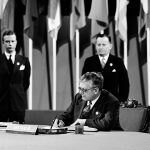Sport in Australia: global engagement, national and local significance
Australia is no backwater in world sport and hosts big international tournaments each year. Daryl Adair says a balance of global and local events is important for the sustainability of the Australian sport marketplace.
Although Australia has a modest population of 23 million people, it is home to one of the most dynamic, yet crowded sport marketplaces in the world. Australia for example is the only country with four professional football codes. Even where athletes are semi-professional or amateur there are numerous national leagues, such as for netball, baseball, field hockey, ice hockey and gridiron.
The logistics of achieving national competitions are considerable given that Australia is a continent of vast size. Whereas the biggest sport organisations, such as the AFL and the NRL, rely principally on broadcasting revenue in order to function, lower profile sports typically draw upon funding provided by the Australian Sports Commission.
Unlike other cultural forms, such as music, dance, theatre, art and literature, sport is unique because it is structured as competition between individuals and teams and, just as importantly, it provides an empirical measure of success – the scoreboard.
This helps to explain why sport and nationalism are such an intoxicating mix: fans are able to bask in the reflected glory of their country’s athletes or mourn their failures. In Australia, as with many other countries, there is intense excitement during the Olympics, particularly around medal winning performances and comparative national medal tallies. The scoreboard becomes a de facto ‘measure’ of a country’s self worth.
Sometimes though, just ‘being there’ is important: The Socceroos returned from Brazil without a win and slumped to 76th in FIFA world rankings, but few expected them to be competitive at an event that has always been dominated by European and South American teams. Meanwhile, with remarkably little fanfare, the Kookaburras won the World Cup in Holland. No ticker tape parade for these champions; field hockey is not part of the national conversation in sport.
For some games, such as basketball, baseball and soccer, leaving Australia opens up the prospect of stronger competition and considerably more money. Numerous Australian athletes ‘fly the flag’ capably in many sports on the world stage: Cadel Evans won the Tour de France in 2011, Mick Fanning was crowned the surfing world champion in 2013, while Adam Scott is currently the world’s no. 1 ranked golfer.
Australia is hardly a backwater in world sport: each year it hosts the Australian Open Tennis tournament and the Australian F1 Grand Prix, both of which reach international audiences. Super 15 rugby, played in Australia, New Zealand and South Africa, is expected to expand to either Japan or Singapore, with Argentina also a potential inclusion. In 2015 the cricket’s World Cup will be played in Australia, as will the Asian Cup in football.
The dynamics of Australian sport are, of course, just as significant at home as they are abroad. The Melbourne Cup and the Sydney to Hobart yacht race, while open to entrants from abroad, are both national institutions. State of Origin rugby league is decidedly parochial – only NSW and Queensland compete – but it is a high point of the sporting calendar, with enormous television ratings. The AFL, which is basically unknown outside these shores, is one of this country’s few distinctive cultural creations and has been remarkably resilient.
Global engagement in sport is alluring and beneficial, but what happens at ‘home’ can be just as exciting and significant. A balance is imperative, for the sustainability of the Australian sport marketplace depends overwhelmingly on the support of locals.
Daryl Adair is Associate Professor of Sport Management at UTS Business School. His research interests include gender relations in sport, race and ethnicity in sport, and drugs in sport.














